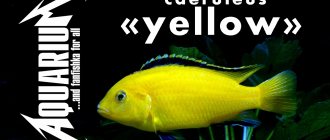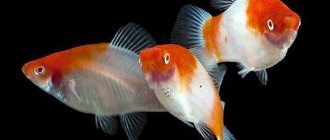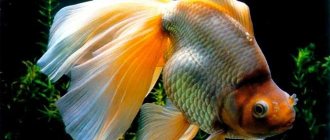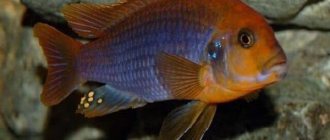Carolina Azolla is distributed in water bodies of North, South and Central America, in both tropical and subtropical regions. Found in ponds, lakes and slow-flowing rivers. In Europe it is extremely rare due to climatic conditions. Introduced in Asia. This is a beautiful small aquatic plant, 1-2 cm high. Azolla is a fern; it has no roots; they are replaced by underwater leaves. Floats on the surface of the water, its small leaves are arranged in pairs, like tiles, on a branched stem. An annual plant, and plants growing in tropical waters are perennial. Azolla carolina has pinnately branched, double-rowed, imbricate, finely cut, oval leaves 5-10 mm long, which makes it look like lace moss. Globular sori are attached at the base of the submerged leaf.
The stem is horizontal, somewhat forked, the rhizome is weakly expressed and has the appearance of a thin cone with small branches of roots, hanging in the water. The plant is a beautiful bluish-green color above, pinkish below. In bright sunlight, it can produce large amounts of anthocyanins, turning the leaves a rich red color.
Description
The genus Azolla from the Salviniaceae family includes 7 species.
This interesting plant is a floating fern, the size of which is several times smaller than that of its land-based counterparts. Only one species can boast a 25-centimeter rhizome. All others have branching, free-floating roots reaching a length of only 2–3 cm.
The stems of the aquatic plant are densely covered with tiny oval leaves. Leaf blades are double. Their lower part is under water, the upper part is on the surface. Numerous leaves create a beautiful openwork pattern on the water surface.
Azolla is used not only for decorating an aquarium. It is actively bred in containers with viviparous fish. In dense thickets, the fry find reliable shelters.
The blue-green alga Anobena lives in symbiosis with Azolla. The lower plant tirelessly extracts nitrogen and shares it with the flower.
It is acceptable to use Azolla for decoration of open reservoirs.
Uses of Azolla
In addition to its decorative purpose, water fern has a number of practical uses. In agriculture, the plant is used as nitrogen fertilizer for fields and feed for poultry.
Azolla, as a plant for ponds, is used to decorate an aquarium. Compared to other aquatic plants, Azolla has a number of advantages. The root system is formed by bundles of filamentous processes in which the fry find shelter. The plant is not susceptible to being eaten by underwater inhabitants; it creates shade and partial shade for algae and fish, which prefer an indirect source of light.
Growing
Azolla is a very easy plant to grow. In warm water and good lighting, it quickly fills the surface of the aquarium. Therefore, from time to time it is necessary to remove part of the colony so as not to deprive the remaining inhabitants of the container of light.
In nature, Azolla dies off during the winter. In indoor floriculture, the dormant period can be canceled. To do this, it is enough to provide the plant with long daylight hours. However, in this case, the flower must be fed with mineral fertilizers to prevent depletion of its own reserves.
There is another way to preserve the plant in winter. The flower is placed in a container with sphagnum moss and placed on the bottom shelf of the refrigerator or any other place where the air temperature does not exceed +12°C. In April, Azolla can be returned to the aquarium.
If the owner is ready to sacrifice the “winter decorativeness” of Azolla, then the plant that has sunk to the bottom will be reborn from spores in the spring.
Spreading
Azolla completely covered the entire reservoir.
The plant’s homeland is North America. Azolla grows in tropical and subtropical regions. These include the Americas, Africa, Madagascar, India, Southeast Asia, China, Japan, Malaysia, the Philippines, mainland New Guinea and Australia. The plant grows on the surface of small, still ponds or reservoirs without the influence of currents at low and medium altitudes.
Illumination
To achieve uniform development of azolla throughout the calendar year, you need to provide good light. The sun's rays are considered the most successful. But in cold seasons additional lighting is necessary.
A floating plant will always be green if you use lamps in addition to natural light from autumn to spring. Their intensity must be at least 2 W per 1 liter.
Important! For normal growth and spectacular coloring, the total duration of natural and artificial lighting should be 12 hours.
Appearance
The leaves have upper and lower lobes, the lower part is thinner and absorbs micronutrients from the water, and the upper part is located above the surface of the water and is responsible for the synthesis process. In summer, the leaves are bright green, and in winter they turn brown. The leaves are very small, no more than 1 mm wide and up to 1.5 mm long.
Aquatic fern is able to absorb nutrients completely over its entire surface. The floating azolla strives to take over all the free space as quickly as possible, so it must be seated regularly. Some aquarists plant Azolla carolina as a shade plant.
Links[edit]
- ^ ab In: Encyclopédie Méthodique, Botanique
1 (1): 343. 1783. “The name is Azolla Lam.”
Tropicos
.
St. Louis, MO: Missouri Botanical Garden. Retrieved February 19, 2010. Abstract: sp. Nov link to specimens of the type Azolla filiculoides
HT:
Azolla filiculoides - Li, Fei-Wei; Brower, Paul; Carretero Field, Lorenzo; Cheng, Shifeng; de Vries, Jan; Case, Pierre-Marc; Ailey, Ariana; Koppers, Niels; Kuo, Li-Yaung (2018-07-02). "Fern genomes shed light on land plant evolution and cyanobacterial symbiosis". Nature Plants
.
4
(7): 460–472. DOI: 10.1038/s41477-018-0188-8. ISSN 2055-0278. PMC 6786969. PMID 29967517. - Weber, Ewald (2017). Invasive Plant Species of the World: A Reference Guide to Environmental Weeds. paragraph 65.
- Evrard, C.; Van Hove, K. (2004). "Taxonomy of American Azolla
(Azollaceae): a critical review".
Systematics and geography of plants
.
74
: 301–318. - “The name is Azolla Lam. Subordinate taxa". Tropicos
. St. Louis, MO: Missouri Botanical Garden. Retrieved February 19, 2010. - "Query results for the genus Azolla". IPNI
. Retrieved February 19, 2010. - Hussner, A. (2006). "NOBANIS - Invasive Alien Species Fact Sheet - Azolla filiculoides" (PDF). Northern European and Baltic online database of invasive alien species
. Heinrich Heine Universität, Düsseldorf. Retrieved February 19, 2010. - ^ B s d e Arnold, California (1955). "Tertiary Azolla from British Columbia" (PDF). Contributions of the museum named after. Paleontology, University of Michigan
.
12
(4): 37–45. - Vaida, V; McLaughlin, S. (2005). "A new Maastrichtian-Paleocene Azolla
from Bolivia, with a comparison of worldwide data on coeval
Azolla
."
Alcheringa: Australasian Journal of Paleontology
.
29
(2): 305–329. DOI: 10.1080/03115510508619308. S2CID 128643041. - Iwao Watanabe, Nilda S. Berja (1983). "Growth of four Azolla species under the influence of temperature". Aquatic botany
.
15
(2): 175–185. DOI: 10.1016/0304-3770 (83) 90027-X. - “Hasan, M. R.; Chakrabarti, R., 2009. Use of algae and aquatic macrophytes as feed in small-scale aquaculture: a review. FAO Technical Paper on Fisheries and Aquaculture, 531. FAO, Rome, Italy." fao.org/
. Retrieved August 18, 2014. - Arctic Azolla Event - Geological Society
- "FAO Figures".
- ^ ab "Mosquito Fern". America's Wetlands Resource Center
. Loyola University, New Orleans. Retrieved November 10, 2007. - Jump up
↑ Wagner, G. M. (1997).
" Azolla
: a review of its biology and uses".
Bot. Ed
.
63
: 1–26. DOI: 10.1007/BF02857915. S2CID 347780. - Moore, A. W. (1969). " Azolla
: biology and agronomic significance".
Bot. Ed
.
35
: 17–35. DOI: 10.1007/BF02859886. S2CID 42431293. - Zimmerman, William J. (1985). “Biomass and pigment production in three Azolla
II isolates.
Reaction to light and temperature stress." Anna.
Bot .
56
(5):701–709. DOI: 10.1093/oxfordjournals.aob.a087059. - Cohen, M. F.; Meziane, T.; Tsuchiya, M.; Yamasaki, H. (2002). "Feeding restraint of Azolla in relation to deoxyanthocyanin and fatty acid composition" (PDF). Aquatic botany
.
74
(2): 181–187. DOI: 10.1016/S0304-3770(02)00077-3. Archived from the original (PDF) on November 22, 2008. Retrieved January 22, 2010. - Brinkhuis, H.; Schouten, S.; Collinson, Maine; Sluijs, A.; Sinninghe Damsté, J. S.; Dickens, G. R.; Huber, M.; Cronin, T.M.; Onodera, J.; Takahashi, K.; and others. (2006). "Episodic fresh surface waters in the Eocene Arctic Ocean". Nature
.
441
(7093):606–9. DOI: 10.1038/nature04692. HDL: 11250/174278. PMID 16752440. S2CID 4412107. Retrieved October 17, 2007. - ^ ab Kempf, E. K. (1976). “Low magnification is the extreme end of electron microscopy.” Information about ZEISS
.
21
(83): 57–60. - An Evolutionary SURVEY of the Plant World, Robert F. Scagel, Robert J Bandoni, Glenn E. Rouse, WB Schofield, Janet R. Stein, and TM Taylor, 1965: Belmont, California, Wadsworth Publishing Co., Inc. , 658 pp.
- P. Kamalasanana Pillai, S. Premalatha and S. Rajamony. "Azolla - an environmentally friendly livestock feed substitute". Farming Matters Magazine. Retrieved January 14, 2008.
- T. R. Preston and E. Murgeitio. "Sustainable intensive livestock production systems for the humid tropics". FAO. Retrieved September 28, 2011.
- Banack, S. A.; Cox, P. A. (2003). "Biomagnification of cycad neurotoxins in flying foxes: implications for ALS-PDC in Guam." Neurology
.
61
(3): 387–9. DOI: 10.1212/01.wnl.0000078320.18564.9f. PMID 12913204. S2CID 38943437. - Erik Sjodin. "Azolla, BMAA and neurodegenerative diseases". Retrieved January 8, 2015.
- “Are toxins in seafood the cause of ALS, Alzheimer's and Parkinson's disease? | DiscoverMagazine.com". Discover the magazine
. Retrieved September 13, 2021. - Williams, Amy Bennett, Documentary on Algae and Public Health Debuts to Sold Out
, Fort Myers News-Press, August 7, 2021 - Sjodin, Eric (2012). Azolla cooking and growing project
. ISBN 978-9198068603. - Agnihotri, Vijay K. (2014). "Anabaena flos-aquae." Critical Reviews in Environmental Science and Technology
.
44
(18): 1995–2037. DOI: 10.1080/10643389.2013.803797. S2CID 84472933. - "The East discovers Azolla". Azolla Foundation
. Retrieved August 18, 2014. - Mayer, Landon; Okech, Bernard A.; Mwobobia, Isaac K.; Kamau, Anthony; Muiruri, Samuel; Mutiso, Noah; Nyambura, Joyce; Mwatele, Cassian; Amano, Teruaki (2008). Mayer, Landon (ed.). "Use of integrated malaria management reduces malaria incidence in Kenya". PLOS ONE
.
3
(12): e4050. DOI: 10.1371/journal.pone.0004050. PMC 2603594. PMID 19115000. - Invasive non-native species (UK) - Water fern - Inside ecology
- Robert L. Irwin; Subhas K. Sikdar (1998-01-08). Bioremediation Technologies: Principles and Practice. paragraph 102. ISBN 9781566765619.
2.Home care
2.1. Azolla content temperature
The optimal temperature range is considered to be from 20 to 28° C. Some species tolerate short frosts down to -5° C.
2.2.Lighting
Partial shade or direct sunlight. Heavily shaded areas should be avoided when growing.
↑ Up,
2.3.Care
Azolla will grow well at temperatures between 20 and 28°C.
2.4. Soil for Azolla
Fresh water or wet mud, ferns die within hours if they dry out. Azolla can be grown in ponds or specially dug holes; it spreads quickly. Strong water flow can cause damage to plant leaves, so it is better to choose a standing pond with a pH between 4 and 7. Plant roots should not come into contact with the soil at the bottom of the pond or pool, as this can lead to nutrient deficiency.
↑ Up,
2.5.Feeding
Not required
2.6.Purpose
Azolla floats on the surface, so it is used exclusively for decorating small ponds or pools. With sufficient lighting, it grows quickly and covers the entire surface of the reservoir. Azolla is grown as animal feed and used in rice crops to retain nitrogen and suppress weeds. Currently, targeted selection of azolla is being carried out in order to obtain more frost-resistant species with a high reproduction rate.
↑ Up,
2.7.Flowering time
Doesn't bloom.
2.8.Air humidity
High, at the slightest overdrying the azolla dies.
2.9. Watering Azolla
In its natural environment, Azolla fern grows on the surface of water bodies or in heavily swampy areas, so this plant is not afraid of floods and it is worth keeping the soil constantly moist.
↑ Up,
2.10.Transfer
The plants are placed in a swampy area or pond in the spring, and after a week it is worth completely collecting the fern, as it very quickly covers the entire surface of the pond and the fish begin to suffocate from lack of oxygen.
2.11. Reproduction of Azolla
Vegetatively with various plant fragments. Azolla reproduces with extraordinary speed. Even a small shoot thrown into water, under good conditions, can cover an area of up to 1 square meter in 2 - 3 weeks.
Azolla can completely cover the surface of a pond or lake within a few weeks or months. Under favorable environmental conditions, it reproduces by spores, carried through the air in the feathers of waterfowl.
↑ Up,
Importance of paleoclimatology[edit]
Main article: Azolla Event
A study of Arctic paleoclimatology showed that Azolla,
may
have played
a significant role in reversing the increase in the greenhouse effect that occurred 55 million years ago, which transformed the region around the North Pole into a hot, tropical environment.
This study was carried out by the Institute of Environmental Biology at Utrecht University. This indicates that massive patches of azolla
growing on the (then) freshwater surface of the Arctic Ocean consumed enough carbon dioxide from the atmosphere to reduce the global greenhouse effect, eventually leading to the formation of ice sheets in Antarctica and the current "Ice Age" ". This theory was called the Azolla event.
Plant propagation methods
Fern propagation methods are also interesting; it can be either vegetative or sexual. The fern azolla produces male and female spores, which is not typical for other azolla species.
[adsp-pro-6]
But Azolla usually reproduces by division. This procedure must be carried out in the summer, since it is during this period that the broken off side shoots take root well.
In summer, Azolla reproduces well by dividing an adult plant.
Content
The temperature of the aquarium water can fluctuate within fairly wide limits. The plant feels good both in moderately warm water at a temperature of about 20 ° C, and in a tropical aquarium at a temperature of 28 ° C. If the temperature drops to 16 °C or lower, this leads to growth stopping; after some time, the leaves of the plant begin to rot and it is immersed in water. The spores preserved in the bottom silt give birth to new plants in the spring.
As for water parameters, soft water with a neutral/slightly acidic pH reaction is best suited for Azolla Carolina.











